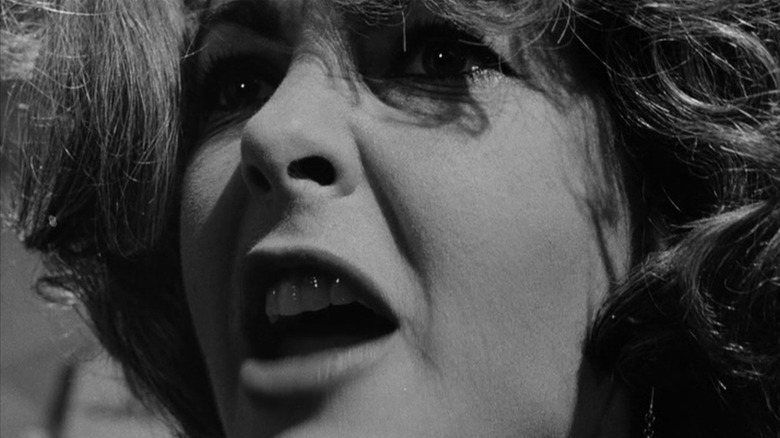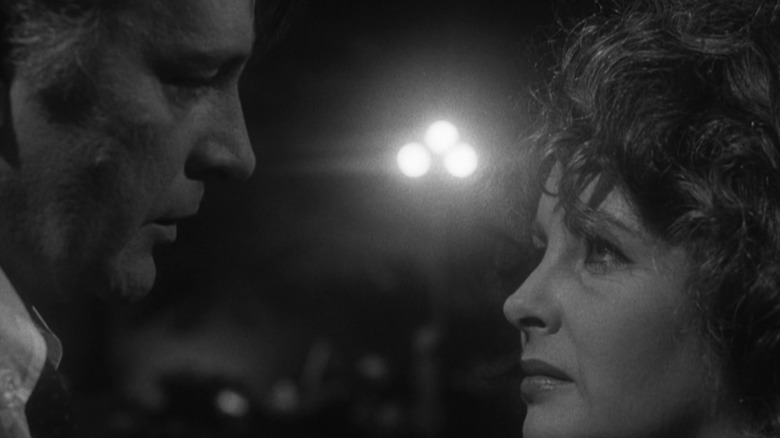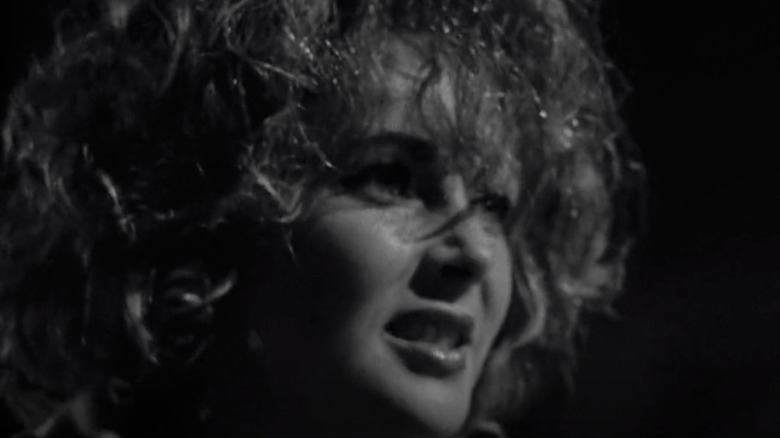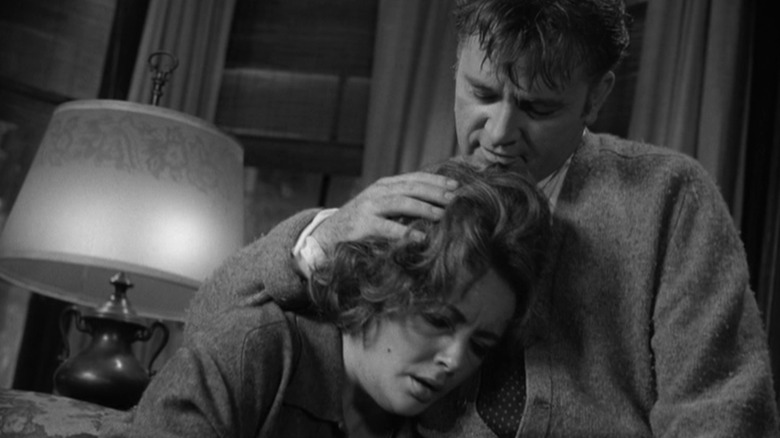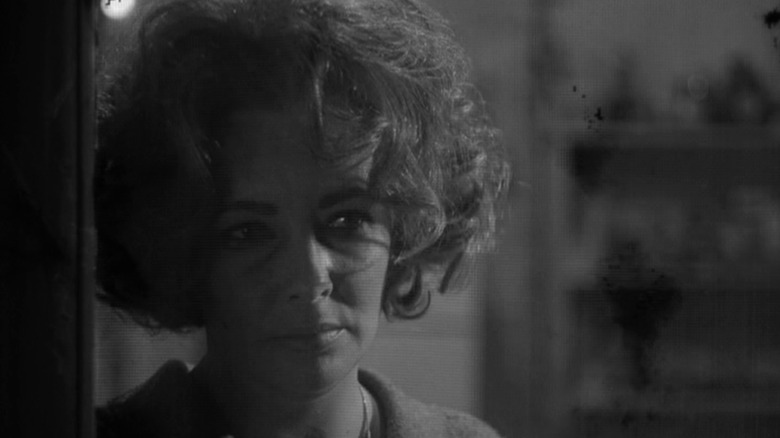Elizabeth Taylor Threw Vanity To The Wind For Who's Afraid Of Virginia Woolf?
"Who's Afraid of Virginia Woolf?" opens with an idyllic scene of an older couple taking a late night stroll around a college campus. A soft tune plays over the scene as the opening credits fade in and out over the picture. If you're a first time watcher, you'd be forgiven for assuming you're about to dive into an easily categorized and digestible movie; a whirlwind romance perhaps, or maybe even a romantic comedy, but you'd be devastatingly wrong.
Before becoming a film, "Who's Afraid of Virginia Woolf?" was a highly successful Broadway play, written by Edward Albee, that earned five Tony Awards. In 1966, the movie adaptation was nominated for 13 Academy Awards and won five of them. Often, highly awarded and celebrated films aren't happy ones. Instead, they're typically pieces that are brave enough to explore the uglier truths of humanity and our interactions with each other. This Oscar-winning film is no exception.
Despite its idealized opening, "Who's Afraid of Virginia Woolf?" focuses on a highly toxic marriage between Martha (Elizabeth Taylor) and George (Richard Burton), and the unbelievable lengths they will go to in order to make each other happy and miserable. The story explores the space between reality and illusion through a relationship bursting with discontent and resentment.
Legendary actress Elizabeth Taylor, as famous for her stunning beauty as she was for her talent, threw herself into the role of a forty-something, disappointed, and heartbroken woman, who finds herself stuck in a love/hate relationship with the only man she's ever loved. According to an interview with the film's editor, Sam O'Steen, Taylor embraced a thicker waist, smudged makeup, and a potential concussion for the role, which turns a bitter abuser into a tragic figure.
What happens in Who's Afraid of Virginia Woolf?
Immediately after the calm opening, Martha and George start bickering and never really stop. They've been at this so long that it's become a sick and twisted game for them to see how much they can hurt each other. As the daughter of the university president, Martha is obligated to have a new biology professor, Nick (George Segal), and his wife, Honey (Sandy Dennis), over for drinks. Even the presence of another couple doesn't stop the arguing.
Martha and George loved each other at first, but it quickly turned to resentment and disappointment when their life didn't go as planned. Martha mocks George's inability to progress beyond an associate professor, and George constantly degrades Martha for her alcoholism, but neither of them ends the marriage. In fact, they do everything they can to try to keep the highly dysfunctional relationship together, even if it means relying on a mutually agreed fiction.
The biggest disappointment in George and Martha's life came from their inability to conceive children. The relationship is so unhealthy and dysfunctional that the couple deals with the trauma by creating an imaginary son. The only rule is that they must never mention this son to anyone else. Martha breaks this rule in a discussion with Honey, and George punishes her by "killing" the fictional son. Martha falls to the floor, crying hysterically over a child that never actually existed, as the husband who killed him tries to comfort her.
Vanity falls to dysfunction
Experiencing a toxic relationship causes both characters to have emotional reactions. George slowly loses control and becomes physically violent with Martha, who becomes emotionally abusive by belittling and humiliating George. It's certainly interesting to watch these characters unravel emotionally, but watching Martha's physical appearance deteriorate is just as captivating.
With violet eyes, porcelain skin, and dark hair, Taylor was widely regarded as one of the most beautiful women in classical Hollywood, and frequently took roles that celebrated that beauty, like "Cleopatra" and "Cat on a Hot Tin Roof." The 33-year-old star, however, had no qualms about throwing away such striking beauty in order to portray a 52-year-old, emotionally abusive, and broken woman.
Taylor gained weight for the role, which, along with smudged makeup and a wig, helped make her look older. According to the film's editor, Sam O'Steen, the Hollywood beauty embraced the opportunity to leave vanity behind:
"She was into it. She even picked this one blouse that bunched up so her stomach would show. And she would make sure she smeared her lipstick so it would match the previous shot, stuff like that. She really didn't care how bad she looked, she was a pro."
Martha's deteriorating appearance coincides with her emotional state and the mental break after the death of her fictional son. If Taylor appears on screen in her typical perfect form, it would be harder to understand the devastating impact of all this on the character.
In addition to vanity, Taylor also threw caution to the wind, according to O'Steen:
"There was also a scene we shot outside the roadhouse where she was trying to hit George and he hurled her away. She kept hitting her head against the car, and didn't complain, but they did have a doctor examine her to make sure she was okay."
That's dedication!
'Sad, sad, sad'
After watching the film, it's easy to see why Taylor committed so deeply to the role. The film is an honest and brutal look at a dysfunctional marriage, and all the complex feelings that take place within that relationship. We see Martha emotionally abuse her husband throughout the film, constantly pointing out his failures as a husband, and denigrating his job as an associate professor. These insults often result in violence and cruelty from George, and it's easy to dismiss both of these characters as terrible people, until we get a small glimpse into the reasons for the toxic dynamic.
In one of the most beautiful moments of the entire movie, Martha explains that George is the only man who has ever made her happy, and that she can't forgive him for it:
"George, who is out somewhere there in the dark, who is good to me, and whom I revile; who can keep learning the games we play as quickly as I can change them; who can make me happy and I do not wish to be happy. Yes, I do wish to be happy. George and Martha: Sad, sad, sad. Whom I will not forgive for having come to rest, for having seen me and having said, 'Yes, this will do.' Who has made the hideous, the hurting, the insulting mistake of loving me and must be punished for it."
It's clear from the first argument that Martha has issues with her husband, but it isn't until this moment that we learn what they are.
Tragic Martha
Martha admits in the monologue that she loves George, despite how horrible he is to her, and she believes that he loves her. It's incredibly sad that she sees abuse and cruelty as love. But it's not nearly as tragic as her assumption that she does not deserve love, and that anyone who attempts to care for her must be punished.
We are left to speculate as to why she feels this way. Maybe her self-hatred spawns from being raised by an overbearing father, or a seemingly absent mother, or her inability to have a child, but we'll never know for sure.
The heart-wrenching monologue is some of Taylor's best work, and single-handedly changes our perception of the character from a bitter and abusive wife to a tragic figure. It is suddenly clear that Martha hates herself way more than anyone watching the film ever could, ensuring viewers will feel sympathy for her when she loses her fictional child. This speech changes the entire viewing experience of the movie and seals the emotional impact of the ending. Without it, the film isn't nearly as heartbreaking or beautiful.
Elizabeth Taylor's willingness to shed vanity and embrace a complex character won her a fifth Academy Award and led to a performance cemented in cinema history that will never lose its devastating beauty.
